|

FIG Working Week 2011 - Bridging the Gap between Cultures
Biggest FIG Working Week strengthens links between cultures
Marrakech, Morocco, 18-22 May 2011
The FIG Working Week Bridging the Gap between Cultures and the
XXXIV General Assembly was held in Marrakech, Morocco from 18 to 22
May 2011. The Working Week included also the 6th National Congress of ONIGT.
The Ordre National des Ingénieurs Géomètres topographes (ONIGT) was at the
same time the local host of this year's Working Week.
The FIG Working Week 2011 turned out to be the biggest FIG Working
Week ever both in the size of the exhibition and the number of participants.
More than 1,500 participants from 90 countries attended. The technical
programme comprised of more than 90 technical sessions, workshops and
special forums. Total number of presented papers was almost 450. The Working
Week was held at the fully packed Palais des Congrès in Marrakech.
The Working Week was organised under the patronage of His Majesty King
Mohammed VI of Morocco. In the exotic city of Marrakech for sure cultures
have been bridged. Meetings with young surveyors, a specific China forum,
meetings with Moroccan, Mediterranean and Arab surveyors, and gathering of
the ‘francophone’ world – and big participation from Africa – it was a big
mix resulting in dynamic and multi-linguistic sessions - and acclaimed as a
big success.

FIG Fanfare at the Opening Ceremony. |
Opening ceremony and Plenary Sessions
The opening ceremony at the Palais des Congrès gathered about 1,200
people to listen to the opening speeches. The Working Week was opened by FIG
President
CheeHai Teo and ONIGT President Aziz Hilali. The opening address
was given by Mr. Karim Ghellab, Minister of Infrastructure and
Transport who addressed the conference on behalf of Prime Minister Abas
El Fassi. Several ministers attended the Opening ceremony and Mr.
Aziz Akhennouch, Minister of Agriculture and Marine Fishery co-sponsored
the welcome reception the previous evening.
Welcome greetings were also presented by President Sarkis Fadous,
Arab Union of Surveyors, President François Mazuyer, Fédération des
Géomètres Francophones, FGF and Vice President Fausto Savoldi,
Mediterranean Union of Surveyors, UMG that all organised their general
meetings during the week. The FIG fanfare and the national anthem of Morocco
brought festivity to the opening ceremony moderated by Prof.
Mohammed Ettarid, Chair of the local organising committee.
The Working Week included three plenary sessions addressing different
aspect of the conference theme on bridging cultural gaps.
The first session was titled "Knowledge and Technology Bridging the
Gap between Cultures". This session and also the Working Week was kicked
off by presentations from President Teo and President Hilali. In his opening
remarks President Teo expressed optimism that together, "we can to be a
Profession, armed with knowledge and best practices, extending the
usefulness of surveying for the benefit of society, environment and economy,
increasingly positioned in significance and relevance, next door to
everywhere".
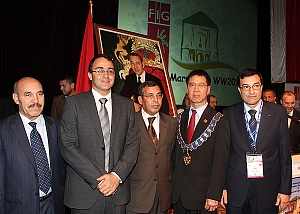
Moroccan ministers and President CheeHai Teo, FIG and
President Aziz Hilali, ONIGT after the opening.
|
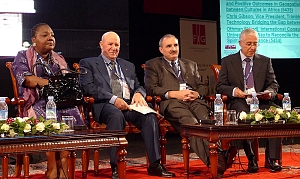
Ms.Aida Opoku-Mensah, ECA, Othman Skiredj, Chris
Gibson, Trimble and session chair Mohammed Ettarid in the
first plenary session. |
The first keynote speaker was Ms. Aida Opoku-Mensah, Director of
UN Economic Commission for Africa, Division of ICT. She spoke about "Bridging
the Gap: The Role of ICTs & Spatial Technologies in Empowering Communities"
focussing on concrete leverage of Information and Communication Technology:
link “where you are” where ICT is concerned because there is ICT
literacy. Her main message was that it is not only about the technology but
also about acceptation of ICT and capacity building.
Chris Gibson, Vice President, Trimble Navigation spoke about the
conference theme "Bridging
the Gap between Cultures". His clarified clearly that where GPS is
concerned there is no need to learn the conventional survey approaches but
that you can now ‘step in’ directly. Still education on the GPS tools is
needed of course. You can work in different context using the same
technology. The final presentation was given by Dr. Othman Skiredj
from Morocco who spoke about the
theory of the creation of the universes and of spiritual inheritance.
The second plenary session "Governance and Regionalization" was at
the same time announced as the 6th National Congress of ONIGT. The session
moderated by Houde Ait-Mik, World Federation of Engineering
Organizations and Vice President Dalal S. Alnaggar was opened by the keynote
presentation of President Aziz Hilali, ONIGT. The second presentation was
made by Abdouh Abdellatif, Secretariat of Consultant Board on the
Moroccan perspective to governance and regionalization. The most interesting
presentation was made by FIG Honorary President Holger Magel,
Technische Universität München, Germany: "Governance
and Regionalization: New Paradigms for Transparent Politics and Accountable
Civic Engagement".
The last plenary session focussed on environmental issues and sustainable
development. It was co-chaired by Mohammed Timoulali, UN ECA and
John Hannah, Chair of FIG Task Force on Surveyors and the Climate
Change. The session started with presentation of Mohammed Nbou,
Secretary of State, Energy Mines, Water and Environment "Problematiques
environnementales et developpment durable au Maroc "Operationalisation de la
CNEDD". The FIG perspective for surveyors was given by Prof. Stig
Enemark, who was appointed as FIG Honorary President in Marrakech. His
address "The
Climate Change Challenge - The Role of Land Professionals" provides a
good background for the FIG agenda for the coming years. The third
presentation was presented by Kamel Ayadi from Tunisia who in his
paper "Elargissement
du Concept de la Durabilité: Gouvernance et Intégrité pour une Meilleure
Durabilité du Développement" discussed among other corruption.
The plenary sessions were very well attended. The interpretation at the
key sessions and in two parallel technical sessions made it easier for the
Moroccan and participants from Francophone Africa to attend the sessions.
Exhibition

The biggest exhibition in the history of FIG Working Weeks at the
Palais des Congrès. Trimble Navigation and ESRI as the platinum
sponsors were located in the centre of the Salle Royale. |
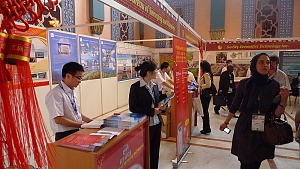
In total 12 Chinese companies exhibited in the Chinese pavilion.
|
At the exhibition in FIG 2011 there were 50 exhibitors occupying all 60
booth available. The exhibition spread out to the Salle Royale and all
foyers at the ground floor of the Palais des Congrès. This made the
tradeshow the biggest at any FIG Working Week in the history. Location of
the technical sessions and coffees served in the exhibition area allowed a
continuous visitors flow to the booth over the three days that the
exhibition continued.
The main exhibitors were the three platinum sponsors of the FIG Working
Week: ESRI and Trimble as the platinum international sponsors and ANCFCC as
the main local sponsor. Trimble Navigation was also the sponsor to the FIG
Foundation Dinner: It also announced to become a Charter Foundation Partner
to the FIG Foundation.
The other exhibitors included international companies and many Moroccan
private companies and public institutions. For the first time there was also
the Chinese Pavilion at the exhibition introducing 12 Chinese companies to
the FIG audience.
The Chinese participation further included the China Forum and the
reception hosted by Dr. Li Pengde, Deputy Director General, State Bureau of
Surveying and Mapping, on 20 May 2011.In the forum titled ‘China
Surveying and Mapping Serves the World’ there attention was given to the
comprehensive set of contents of MapWord, the Chinese own website with geo
spatial data. During the forum the latest survey instruments were also
presented.
The preconference workshop for local surveyors was organised by Trimble
and ESRI as part of their platinum sponsorship.
Technical sessions and forums
The technical programme with more than 90 session offered something for
everyone - the difficulty was in selecting the right sessions. All papers
are available in the proceedings.
Here are some of the key topics. Almost 70 papers were offered to peer
review process. Out of the offered papers more than 30 were presented in the
programme. To the technical programme in total 650 papers were offered and
450 included in the final programme.
A set of technical visits were offered to allow participants to visit
local surveying and other institutions. all these tours were fully booked.
Future of Cadastres
During a
special forum
with international experts on the futures of cadastres (Towards Cadastre
2034) that was organised in co-operation with GIM International that also
published a
special issue on this topic. In the panel discussion it became very
clear that there is a need for an open debate on this issue. Quality
management is a very important task for surveyors, it is important to know
how accurate the map is, but very accurate maps are not always needed. The
discussion was based on an invited reply on a paper of Rohan Bennett
et al from Australia in GIM International. This paper is also published as
the
article of the month in June 2011. Some outcomes from the discussion:
Cadastres are a sustainable basis for integrated (land) information systems.
Considering that for tax purposes or land market cadastres are
indispensible, the cadastre will be the fundament. This requires changes in
the business models: land registries and cadastres should cooperate in
unison or even merge to provide a steady, predictable and sustainable
business model underlying land administration and SDI's. Cadastres are the
basis for integrating spatial information at large scales. In 2034
interoperability will be about processes, interests and organizations.
Collaboration in chains and networks is the dominant way of working and
sharing is the name of the game. Cadastre 2034 should be fit for purpose and
that depends on the context you are operating in: organisations (still) will
be in different stages of development.
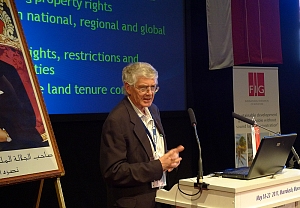
Prof. Ian Williamson at the special session on future
cadastres (Towards Cadastre 2034). |
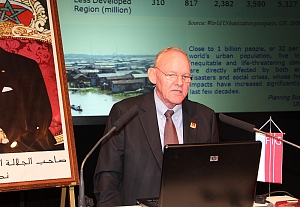
Prof. Stig Enemark discussing the role of land professionals
in the climate change. |
Africa
In the technical programme lot of attention was focussed to ongoing
developments in Northern and Sub Saharan Africa. There were many
representatives from the continent presenting papers and joining the
discussions. The FIG Africa task force organised two round table sessions in
Marrakech. The focus is on the African surveying profession and how it can
best contribute to meet the key challenges of poverty alleviation, economic
growth, and environmental sustainability. In Marrakech of the issues
discussed was the development of a hand book on peri-urban planning, main
theme is slum prevention.
UN Habitat gave an overview of the latest developments on the Social
Tenure Domain Model – an OpenSource Pro Poor software tool for
unconventional support in Land Administration. Attention for the needs and
requirements of poor people was expressed in a more then clear way.
Disaster and Climate
Discussions on disaster management and climate change and the surveyors
role in relation to this was also a hot topic. The recent earth quake in New
Zealand with its terrible impact has also consequences for cadastral maps: a
part of the earth surface disappeared but is still represented on the maps.
There was a discussion on the situation in Haiti, the contribution of the
profession is required for many years here – as in other post disaster
area’s. FIG has also established a task force on surveyors and the climate
change that will also address these issues in the coming years. Prof. Stig
Enemark in his
keynote presentation presented the options and strategies in the road
ahead.
Survey Accuracy
Commission 5 had a very well planned programme in co-operation with
IAG, IGS and AFREF on CORS infrastructures.
It should be recognised in relation to the accuracy of surveys that
(very) high accuracy is in many cases not required nor demanded for. In many
countries it is most important to get the cadastral map finalised and
accessible. It can be a very good approach to start with a lower accuracy
and even impreciseness and to perform quality upgrades later. Approaches
with high accurate results (e.g. 10 cm) do in many cases not result in
complete cadastral coverage.
New Infrastructures
During the Working Week there was also some first, slightly reluctant,
attention on possible future options of using infrastructures as Google
Earth, Open Street Map, Facebook, Wikipedia etc for our work. Can people
built for example their own land administration with participatory and
community based input? Will people determine the boundaries of their lands
with their neighbours – “user dominance”? This already is happening at the
demand side, but in the future many processes will be initiated an enriched
by the processes and information provided by the users. Also relevant is the
access to so called ‘free data’… And: an early warning system for financial
crises after the experiences with mortgages in the US. The development of
so-called authentic or key registers – without data duplications remains an
issue. Global Navigation Satellite Systems will be used more and more –
there are more and more infrastructures with permanent reference stations.
FIG Forums
During the week the already traditional Director General Forum was
organised to discuss the key issues on the agenda of the national mapping
and cadastre agencies. The lively and fruitful discussion was attended by
about 20 leaders from national institutions.
The first Academic Members Forum was attended by 22 universities to
develop the agenda for further co-operation between universities and within
the FIG academic network.
The FIG Corporate members meeting was attended by one third of the
corporate members.
The FIG Young Surveyors Network and Standards Networks continued their
active contribution to the Working Week programme.
Social events
The welcome reception was held at the Mansour Eddahbi Hotel that also
worked as the main conference hotel.
The FIG Foundation Dinner that at the same time was the Moroccan cultural
evening was sponsored by Trimble Navigation. The venue Palais des Jbilates
offered a nice Arabic surrounding for the evening that included Arabic music
and dance.
The conference dinner sponsored by His Majesty King Mohammed VI attracted
thousand participants to Le Pacha Restaurant with international
entertainment and a nice meal.
The additional events included the ONIGT dinner and more information
Commission dinners.

Moroccan music entertained participants at the welcome reception. |
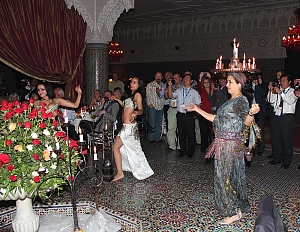
FIG Foundation Dinner that was sponsored by Trimble Navigation in
traditional Moroccan style. |
Conclusion
The General Assembly and its decisions are described in
a separate report.
The Working Week ended with two closing ceremonies one for the 6th
National Congress of ONIGT and the formal Closing Ceremony of the Working
Week after the second General Assembly. In his closing remarks President Teo
trusted that everyone will leave the hospitable city of Marrakech with
memorable moments. But at the same time "we must continue and strive to
bridge the gaps that exist, that will ensure that the profession continues
to enhance its role and relevance to ensure a sustainable future."
At the closing ceremony President Teo acknowledged for the successful
Working Week the local organising committee, especially President and
Congress Director Aziz Hilali, Chair of the LOC Mohammed Ettarid and
Prof. Moha ElAyachi who carried out a big part of the logistics with
FIG. Special thanks were also recorded to the big group of volunteers, young
professionals and students that made the conference memorable.
The next FIG Working Week will be the FIG Working Week 2012 in Rome,
Italy, 6-11 May 2012 including the first FIG Young Surveyors Conference 4-5
May 2012.
More to Read:
Links to documents and reports of the FIG Working Week 2011
and the XXXIV General Assembly in Marrakech, Morocco
 |

































